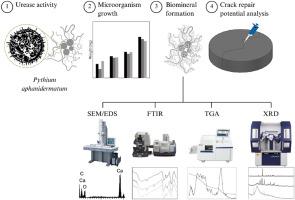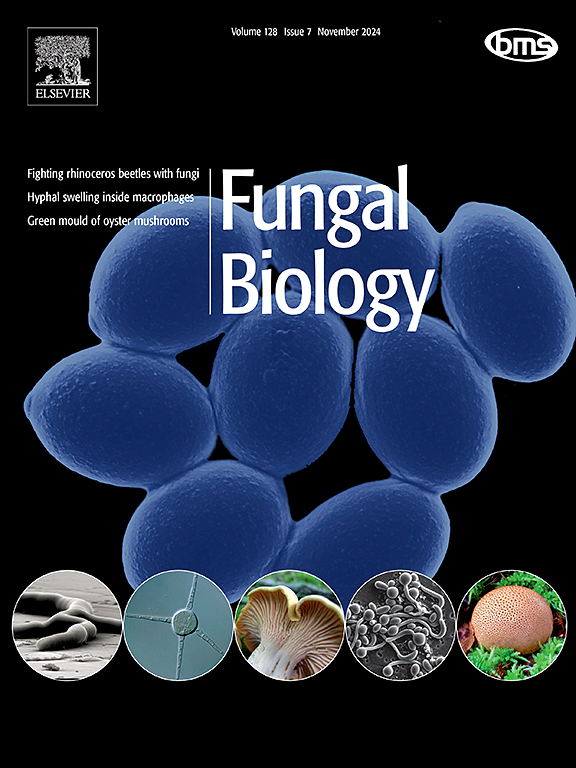An exploratory study on crack healing in cementitious matrices induced by Pythium aphanidermatum
IF 3
3区 生物学
Q2 MYCOLOGY
引用次数: 0
Abstract
The biomineralization of calcium carbonate (CaCO3) mediated by microorganisms has been extensively studied for decades, with a predominant focus on bacteria, algae, and fungi. However, the functional and operational limitations of these species highlight the need to investigate new biological agents. This study aims to evaluate the biomineralization potential of Pythium aphanidermatum, an oomycete from the Chromista kingdom, for crack-healing applications in cement mortars. Its ureolytic capacity to accelerate CaCO3 formation was analyzed, and liquid cultures with controlled concentrations of cells and calcium acetate were designed. Additionally, the microorganism's growth in alkaline media was evaluated. A surface application technique was adapted to determine the crack repair potential in cementitious matrices. Results demonstrated that P aphanidermatum does not necessarily require urea to form CaCO3. A concentration of 105 cells/mL and 100 mM of calcium acetate were optimal for microorganism development through surface application and CaCO3 formation. It was also observed that P. aphanidermatum can tolerate alkaline environments (pH 11). Finally, its filamentous growth allowed partial filling of cracks in carbonated cement mortars. This work expands the scope of biomineralization by incorporating an organism from a previously unreported kingdom into this field, laying the foundation for sustainable and innovative applications in the construction industry.

蛇皮草诱导胶凝基质裂缝愈合的探索性研究
微生物介导的碳酸钙(CaCO3)生物矿化已经被广泛研究了几十年,主要集中在细菌、藻类和真菌上。然而,这些物种的功能和操作限制突出了研究新的生物制剂的必要性。本研究旨在评估一种来自铬菌属的卵菌——蛇皮霉(Pythium aphanidermatum)在水泥砂浆中裂缝修复应用的生物矿化潜力。分析了其加速CaCO3形成的溶尿能力,并设计了控制浓度的细胞和醋酸钙的液体培养。此外,还对微生物在碱性培养基中的生长情况进行了评价。采用表面应用技术测定胶凝基质的裂纹修复潜力。结果表明,pphididermatum并不一定需要尿素来形成CaCO3。105个细胞/mL和100 mM的醋酸钙通过表面施用和CaCO3形成对微生物发育最有利。此外,还观察到假单胞菌能耐受碱性环境(pH值11)。最后,其丝状生长允许部分填充碳酸水泥砂浆的裂缝。这项工作扩大了生物矿化的范围,将一种来自以前未报道过的生物王国的生物纳入该领域,为建筑行业的可持续和创新应用奠定了基础。
本文章由计算机程序翻译,如有差异,请以英文原文为准。
求助全文
约1分钟内获得全文
求助全文
来源期刊

Fungal biology
MYCOLOGY-
CiteScore
5.80
自引率
4.00%
发文量
80
审稿时长
49 days
期刊介绍:
Fungal Biology publishes original contributions in all fields of basic and applied research involving fungi and fungus-like organisms (including oomycetes and slime moulds). Areas of investigation include biodeterioration, biotechnology, cell and developmental biology, ecology, evolution, genetics, geomycology, medical mycology, mutualistic interactions (including lichens and mycorrhizas), physiology, plant pathology, secondary metabolites, and taxonomy and systematics. Submissions on experimental methods are also welcomed. Priority is given to contributions likely to be of interest to a wide international audience.
 求助内容:
求助内容: 应助结果提醒方式:
应助结果提醒方式:


